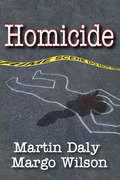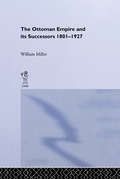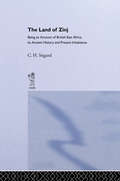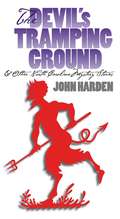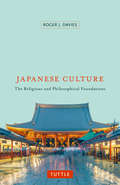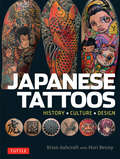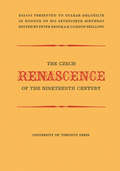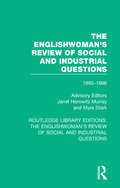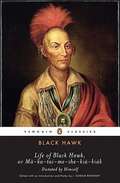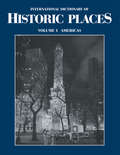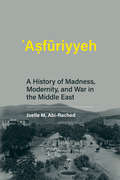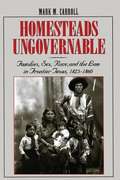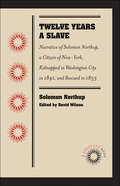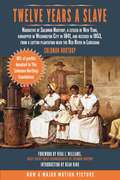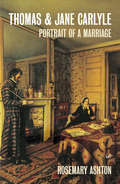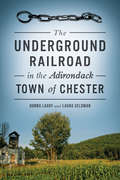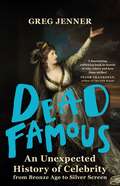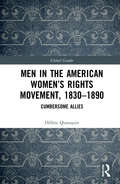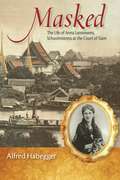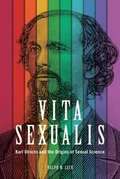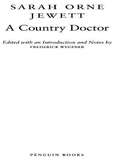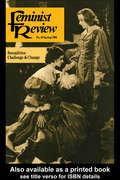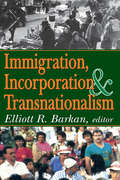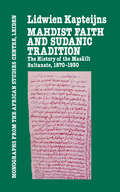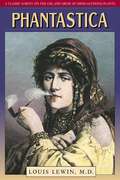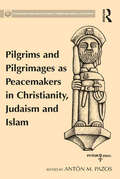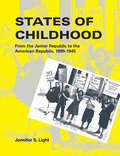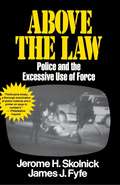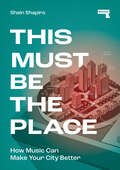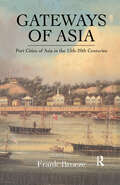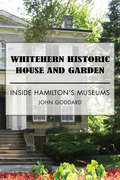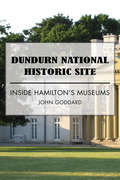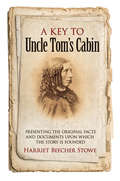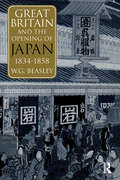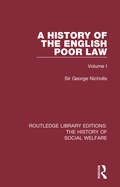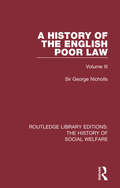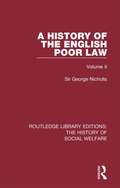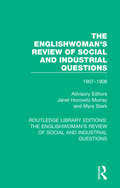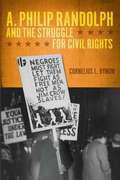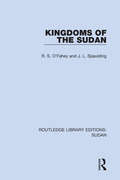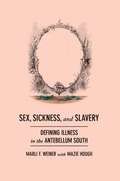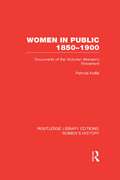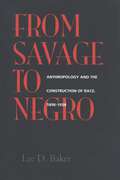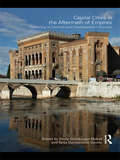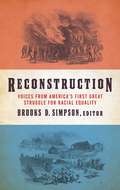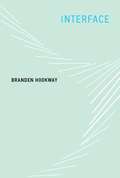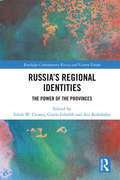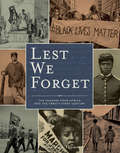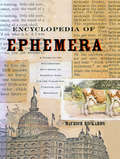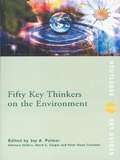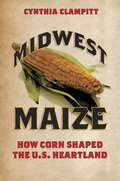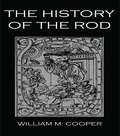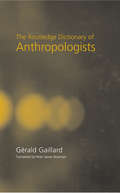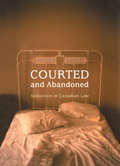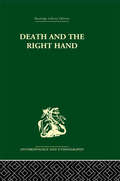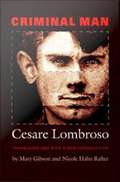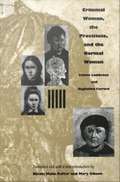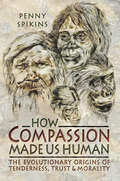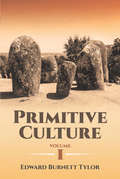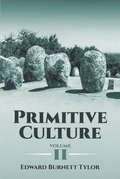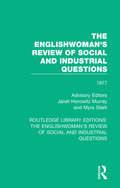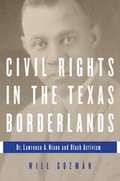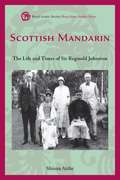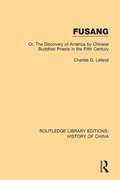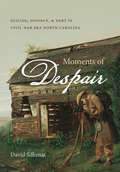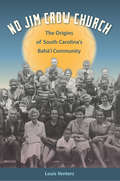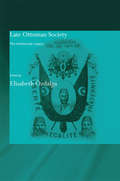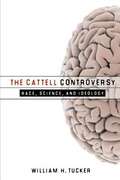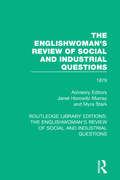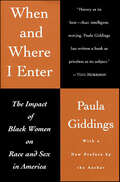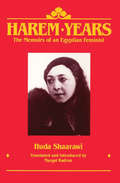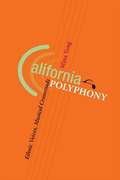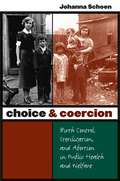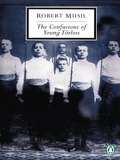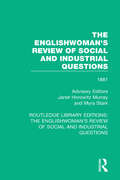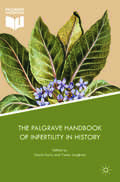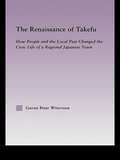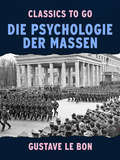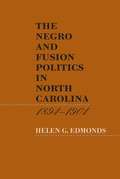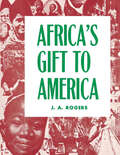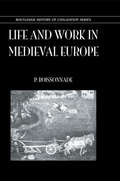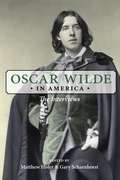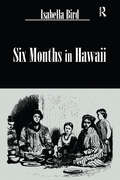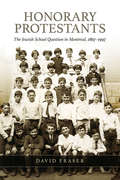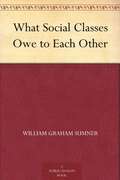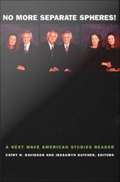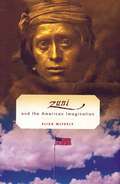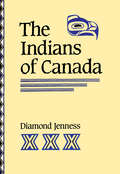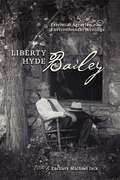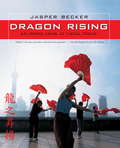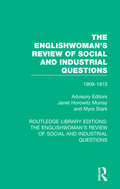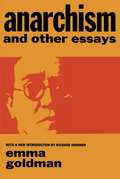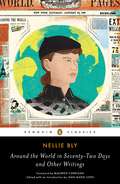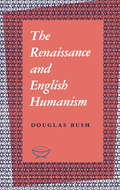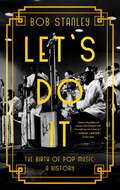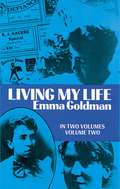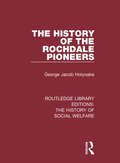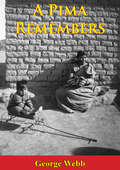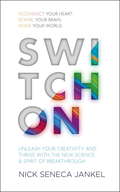- Table View
- List View
Homicide: Foundations of Human Behavior (Foundations of Human Behavior)
by Martin Daly Margo WilsonThe human race spends a disproportionate amount of attention, money, and expertise in solving, trying, and reporting homicides, as compared to other social problems. The public avidly consumes accounts of real-life homicide cases, and murder fiction is more popular still. Nevertheless, we have only the most rudimentary scientific understanding of who is likely to kill whom and why. Martin Daly and Margo Wilson apply contemporary evolutionary theory to analysis of human motives and perceptions of self-interest, considering where and why individual interests conflict, using well-documented murder cases. This book attempts to understand normal social motives in murder as products of the process of evolution by natural selection. They note that the implications for psychology are many and profound, touching on such matters as parental affection and rejection, sibling rivalry, sex differences in interests and inclinations, social comparison and achievement motives, our sense of justice, lifespan developmental changes in attitudes, and the phenomenology of the self. This is the first volume of its kind to analyze homicides in the light of a theory of interpersonal conflict. Before this study, no one had compared an observed distribution of victim-killer relationships to "expected" distribution, nor asked about the patterns of killer-victim age disparities in familial killings. This evolutionary psychological approach affords a deeper view and understanding of homicidal violence.
The Ottoman Empire and Its Successors, 1801-1927
by William MillerFirst Published in 1966. Routledge is an imprint of Taylor & Francis, an informa company.
The Land of Zinj: Being an Account of British East Africa, its Ancient History and Present Inhabitants
by C.H. StiglandPublished in the year 296, The Land of Zinj is a valuable contribution to the field of History.
The Devil's Tramping Ground and Other North Carolina Mystery Stories
by Sue HardenFrom the first colonization at Roanoke Island, the bizarre and inexplicable have shrouded the Tar Heel State. From history and legend, John Harden records ominous events that have shaped or colored state history.
Japanese Culture: The Religious and Philosophical Foundations
by Roger J. DaviesJapanese Culture: The Religious and Philosophical Foundations takes readers on a detailed and thoroughly researched journey through Japan's cultural history.This much-anticipated sequel to Roger Davies's best-selling The Japanese Mind provides a comprehensive overview of the religion and philosophy of Japan. This cultural history of Japan explains the diverse cultural traditions that underlie modern Japan and offers readers deep insights into Japanese manners and etiquette. Davies begins with an investigation of the origins of the Japanese, followed by an analysis of the most important approaches used by scholars to describe the essential elements of Japanese culture. From there, each chapter focuses on one of the formative elements: Shintoism, Buddhism, Taoism, Zen, Confucianism, and Western influences in the modern era.Davies concludes each chapter with extensive endnotes along with thought-provoking discussion activities, making this volume ideal for individual readers and for classroom instruction. Anyone interested in pursuing a deeper understanding of this complex and fascinating nation will find Davies's work an invaluable resource.
Japanese Tattoos: History * Culture * Design
by Brian Ashcraft Hori BennyThinking of getting a Japanese-style tattoo? Want to avoid a permanent mistake? Japanese Tattoos is an insider's look at the world of Japanese irezumi (tattoos).Japanese Tattoos explains the imagery featured in Japanese tattoos so that readers can avoid getting ink they don't understand or, worse, that they'll regret. This photo-heavy book will also trace the history of Japanese tattooing, putting the iconography and kanji symbols in their proper context so readers will be better informed as to what they mean and have a deeper understanding of irezumi. Tattoos featured will range from traditional tebori (hand-poked) and kanji tattoos to anime-inspired and modern works-as well as everything in between. For the first time, Japanese tattooing will be put together in a visually attractive, informative, and authoritative way.Along with the 350+ photos of tattoos, Japanese Tattoos will also feature interviews with Japanese tattoo artists on a variety of topics. What's more, there will be interviews with clients, who are typically overlooked in similar books, allowing them to discuss what their Japanese tattoos mean to them. Those who read this informative tattoo guide will be more knowledgeable about Japanese tattoos.
The Czech Renascence of the Nineteenth Century
by Peter Brock H. Gordon SkillingLiterature and historical writing among the Czechs, as among many other nations lacking a political state, played a vital role in promoting national consciousness. This volume, written to honour the seventieth birthday of the eminent Czech historian Otakar Odložík, contains essays by outstanding scholars from Canada, Czechoslovakia, Britain, and the United States which examine significant episodes in the development of modern Czech nationalism from its origins in the late eighteenth century to the birth of an independent nation after the First World War. The main emphasis is on the middle decades of the nineteenth century, which were crucial for mapping the direction Czech nationalism was to take during the subsequent hundred years. The stand of the Czech and Slovak peoples in the crisis of August 1968 reflected the deep roots of their patriotism which developed during the nineteenth-century national renascence. This volume contains essays on Dobrovský, the pioneer of Czech language studies, and on Palacký, the author of the first great national history, as well as on other facets of literary history which have influenced national feeling. A Prague scholar investigates the social structure of the early Czech patriotic intelligentsia and reaches conclusions which considerably modify hitherto existing views. Two contributions examine the role of the press in the emergence of Czech nationalism; the Matice Ceskà, a leading patriotic literary foundation, is the subject of one of the studies. Slovak and Lusatian Serb, German, and American reaction to the Czech national renascence is examined in a series of chapters. The political expression of Czech nationalism, first during the Year of Revolutions, 1848, and then from the late 1870s until the early years of the twentieth century, is subjected to analysis in several studies. Finally, there is a brief review of the problems associated with the Czech-Slovak background of Tomáš Masaryk, the creator of modern Czechoslovakia. A fitting tribute to an outstanding scholar, this volume makes an important contribution to the literature in English on nineteenth-century Czech lands.
The Englishwoman's Review of Social and Industrial Questions: 1895-1896 (Routledge Library Editions: The Englishwoman's Review of Social and Industrial Questions #28)
by Janet Horowitz Murray and Myra StarkThe Englishwoman’s Review, which published from 1866 to 1910, participated in and recorded a great change in the range of possibilities open to women. The ideal of the magazine was the idea of the emerging emancipated middle-class woman: economic independence from men, choice of occupation, participation in the male enterprises of commerce and government, access to higher education, admittance to the male professions, particularly medicine, and, of course, the power of suffrage equal to that of men. First published in 1984, this twenty-eighth volume contains issues from 1895 to 1896. With an informative introduction by Janet Horowitz Murray and Myra Stark, and an index compiled by Anna Clark, this set is an invaluable resource to those studying nineteenth and early twentieth-century feminism and the women’s movement in Britain.
Life of Black Hawk, or Ma-ka-tai-me-she-kia-kiak
by Black HawkA controversial figure in his day, Black Hawk was the leader of the Sauk American Indian tribe in the early 1800s. The son of the tribe s medicine man, Black Hawk s exploits as a warrior aided his rise to the status of tribal war leader. Here, Black Hawk chronicles his life as well as the story of his tribe, who were forced from their lands in Illinois during a series of skirmishes with American settlers in what came to be known as the Black Hawk War.
The Americas: International Dictionary of Historic Places
by Trudy Ring Robert M. Slakin Sharon La BodaFirst Published in 1996. Routledge is an imprint of Taylor & Francis, an informa company.
Asfuriyyeh: A History of Madness, Modernity, and War in the Middle East (Culture and Psychiatry)
by Joelle M Abi-RachedThe development of psychiatry in the Middle East, viewed through the history of one of the first modern mental hospitals in the region.ʿAṣfūriyyeh (formally, the Lebanon Hospital for the Insane) was founded by a Swiss Quaker missionary in 1896, one of the first modern psychiatric hospitals in the Middle East. It closed its doors in 1982, a victim of Lebanon's brutal fifteen-year civil war. In this book, Joelle Abi-Rached uses the rise and fall of ʿAṣfūriyyeh as a lens through which to examine the development of modern psychiatric theory and practice in the region as well as the sociopolitical history of modern Lebanon.
Homesteads Ungovernable: Families, Sex, Race, and the Law in Frontier Texas, 1823-1860
by Mark M. CarrollWhen he settled in Mexican Texas in 1832 and began courting Anna Raguet, Sam Houston had been separated from his Tennessee wife Eliza Allen for three years, while having already married and divorced his Cherokee wife Tiana and at least two other Indian "wives" during the interval. Houston's political enemies derided these marital irregularities, but in fact Houston's legal and extralegal marriages hardly set him apart from many other Texas men at a time when illicit and unstable unions were common in the yet-to-be-formed Lone Star State.<P>In this book, Mark Carroll draws on legal and social history to trace the evolution of sexual, family, and racial-caste relations in the most turbulent polity on the southern frontier during the antebellum period (1823-1860). He finds that the marriages of settlers in Texas were typically born of economic necessity and that, with few white women available, Anglo men frequently partnered with Native American, Tejano, and black women. While identifying a multicultural array of gender roles that combined with law and frontier disorder to destabilize the marriages of homesteaders, he also reveals how harsh living conditions, land policies, and property rules prompted settling spouses to cooperate for survival and mutual economic gain. Of equal importance, he reveals how evolving Texas law reinforced the substantial autonomy of Anglo women and provided them material rewards, even as it ensured that cross-racial sexual relationships and their reproductive consequences comported with slavery and a regime that dispossessed and subordinated free blacks, Native Americans, and Tejanos.
Twelve Years a Slave: Narrative of Solomon Northup, a Citizen of New-York, Kidnapped in Washington City in 1841, and Rescued in 1853
by Solomon NorthupAfter living as a free man for the first thirty-three years of his life, Solomon Northup was drugged, kidnapped, and sold into slavery, leaving behind a wife and three children in New York. Sold to a Louisiana plantation owner who was also a Baptist preacher, Northup proceeded to serve several masters, some who were brutally cruel and others whose humanity he praised. After years of bondage, he met an outspoken abolitionist from Canada who notified Northup's family of his whereabouts, and he was subsequently rescued by an official agent of the state of New York. Twelve Years a Slaveis his account of this unusual series of events. Northup describes life on cotton and sugar cane plantations in meticulous detail. One slave narrative scholar calls his narrative "one of the most detailed and realistic portraits of slave life. " He also leavens his account with wry humor and cultural commentary, making many parts of the narrative read more like travel writing than abolitionist literature. Twelve Years a Slavepresents the remarkable story of a free man thrown into a hostile and foreign world, who survived by his courage and cunning. A DOCSOUTH BOOK. This collaboration between UNC Press and the University of North Carolina at Chapel Hill Library brings selected classic works from the digital library of Documenting the American South back into print. DocSouth Books uses the latest digital technologies to make these works available as downloadable e-books or print-on-demand publications. DocSouth Books are unaltered from the original publication, providing affordable and easily accessible editions to a new generation of scholars, students, and general readers.
Twelve Years a Slave: Narrative of Solomon Northup, a Citizen of New York, Kidnapped in Washington City in 1841, and Rescued in 1853, from a Cotton Plantation Near the Red River in Louisiana
by Dean King Solomon Northup Vera J. WilliamsThe incredible true story of the kidnapping, enslavement, and rescue of Solomon Northup in the era before the Civil War-now a major motion picture!In 1841, Solomon Northup was a free man living in Saratoga Springs, New York, making a living as a violinist and spending his spare time with his wife and three young children. Lured to Washington, DC, with the promise of a generous sum of money, Northup finds himself drugged, beaten, and sold before he can even begin to comprehend the tragic turn his life has taken. Twelve torturous years of slavery follow, with Northup passed from owner to owner, plantation to plantation, until his eventual rescue in 1853. Following his return to New York, Northup wrote and published this extraordinary book, one of the few accounts of American slavery written from the perspective of a man who had been free before being enslaved.Lost for nearly a century, Twelve Years a Slave offers unprecedented details of the slave markets of Washington, DC, and describes the excruciating life on Southern cotton plantations. In its time, Twelve Years a Slave was a bestseller and ignited a national dialogue on slavery in the years leading up to the Civil War. Northup's unsparing portrayal of the life of a slave captured minds and eventually divided a nation.
Thomas And Jane Carlyle: Portrait of a Marriage
by Rosemary AshtonThey were the most remarkable couple in London: the great sage Carlyle, with his vehement prophecies, and his witty, sardonic wife Jane. It was a strong, close, mutually admiring yet often mutually antagonistic partnership, fascinating to all who observed it. The Carlyles lived at the heart of English life in mid-Victorian London, but both were outsiders, a largely self-educated Scottish pair who took a sometimes caustic look at the society they so influenced - Carlyle through his copious writings, and both through their network of acquaintances and correspondents. Carlyle's fame was confirmed by his Sartor Resartus of 1843, The French Revolution, his lectures on heroes and hero-worship and by his radical account of contemporary industrial Britain in Past and Present, 1843. Both husband and wife were great letter-writers, Carlyle commenting on the matters of the day, dashing off pen portraits of those he met and Jane with her brilliant stories and her sharp, dry humour. Yet despite her brilliance, Jane suffered, especially from Carlyle's infatuation with the lion-hunting Lady Ashburton, and the tensions in their marriage grew. The letters they wrote, both to each other and to others, make theirs the most well-documented marriage of the nineteenth century and give us an unequalled portrait of a famously unhappy marriage. This moving and vivid biography describes their relationship with each other, from their first meeting in 1821 to Jane's death in 1866, and also their relationship with the world outside. Rosemary Ashton's inimitable blend of rigorous scholarship, warm sensitivity and lively wit makes this not only a portrait of a marriage but a picture of a whole age, elegant, erudite and entertaining.
The Underground Railroad in the Adirondack Town of Chester
by Donna Lagoy Laura SeldmanThe Town of Chester in upstate Warren County, New York, was a secret haven for runaway slaves escaping to Canada along the Underground Railroad. The small Adirondack town holds as many as nine confirmed or suspected sites where fugitives once found shelter. Stories abound of residents discovering secret rooms containing beds and other artifacts within their homes. The first abolitionist pastor of the Darrowsville Wesleyan Church, Reverend Thomas Baker, reportedly hid fugitive slaves in the parsonage. Color photographs and interviews with current residents illuminate the region's hidden history with the Underground Railroad movement. With the support of the Historical Society of the Town of Chester, Donna Lagoy and Laura Seldman reveal these courageous stories of local families who risked everything in the pursuit of freedom for all.
Dead Famous: An Unexpected History of Celebrity from Bronze Age to Silver Screen
by Greg Jenner'Fizzes with clever vignettes and juicy tidbits... [a] joyous romp of a book.' Guardian'A magical mystery tour through the history of celebrity - eye opening, provocative, triumphant.' Kate Williams, bestselling author and historian'A fascinating, rollicking book in search of why, where and how fame strikes. Sit back and enjoy the ride.' Peter FrankopanCelebrity, with its neon glow and selfie pout, strikes us as hypermodern. But the famous and infamous have been thrilling, titillating, and outraging us for much longer than we might realise. Whether it was the scandalous Lord Byron, whose poetry sent female fans into an erotic frenzy; or the cheetah-owning, coffin-sleeping, one-legged French actress Sarah Bernhardt, who launched a violent feud with her former best friend; or Edmund Kean, the dazzling Shakespearean actor whose monstrous ego and terrible alcoholism saw him nearly murdered by his own audience - the list of stars whose careers burned bright before the Age of Television is extensive and thrillingly varied. Celebrities could be heroes or villains; warriors or murderers; brilliant talents, or fraudsters with a flair for fibbing; trendsetters, wilful provocateurs, or tragic victims marketed as freaks of nature. Some craved fame while others had it forced upon them. A few found fame as small children, some had to wait decades to get their break. But uniting them all is the shared origin point: since the early 1700s, celebrity has been one of the most emphatic driving forces in popular culture; it is a lurid cousin to Ancient Greek ideas of glorious and notorious reputation, and its emergence helped to shape public attitudes to ethics, national identity, religious faith, wealth, sexuality, and gender roles. In this ambitious history, that spans the Bronze Age to the coming of Hollywood's Golden Age, Greg Jenner assembles a vibrant cast of over 125 actors, singers, dancers, sportspeople, freaks, demigods, ruffians, and more, in search of celebrity's historical roots. He reveals why celebrity burst into life in the early eighteenth century, how it differs to ancient ideas of fame, the techniques through which it was acquired, how it was maintained, the effect it had on public tastes, and the psychological burden stardom could place on those in the glaring limelight. DEAD FAMOUS is a surprising, funny, and fascinating exploration of both a bygone age and how we came to inhabit our modern, fame obsessed society.
Men in the American Women’s Rights Movement, 1830–1890: Cumbersome Allies (Global Gender)
by Hélène QuanquinThis book studies male activists in American feminism from the 1830s to the late 19th century, using archival work on personal papers as well as public sources to demonstrate their diverse and often contradictory advocacy of women’s rights, as important but also cumbersome allies. Focussing mainly on nine men—William Lloyd Garrison, Wendell Phillips, James Mott, Frederick Douglass, Henry B. Blackwell, Stephen S. Foster, Henry Ward Beecher, Robert Purvis, and Thomas Wentworth Higginson, the book demonstrates how their interactions influenced debates within and outside the movement, marriages and friendships as well as the evolution of (self-)definitions of masculinity throughout the 19th century. Re-evaluating the historical evolution of feminisms as movements for and by women, as well as the meanings of identity politics before and after the Civil War, this is a crucial text for the history of both American feminisms and American politics and society. This is an important scholarly intervention that would be of interest to scholars in the fields of gender history, women’s history, gender studies and modern American history.
Masked
by Alfred HabeggerA brave British widow goes to Siam and-by dint of her principled and indomitable character-inspires that despotic nation to abolish slavery and absolute rule: this appealing legend first took shape after the Civil War when Anna Leonowens came to America from Bangkok and succeeded in becoming a celebrity author and lecturer. Three decades after her death, in the 1940s and 1950s, the story would be transformed into a powerful Western myth by Margaret Landon's best-selling book "Anna and the King of Siam" and Rodgers and Hammerstein's musical "The King and I. " But who was Leonowens and why did her story take hold? Although it has been known for some time that she was of Anglo-Indian parentage and that her tales about the Siamese court are unreliable, not until now, with the publication of "Masked," has there been a deeply researched account of her extraordinary life. Alfred Habegger, an award-winning biographer, draws on the archives of five continents and recent Thai-language scholarship to disclose the complex person behind the mask and the troubling facts behind the myth. He also ponders the curious fit between Leonowens's compelling fabrications and the New World's innocent dreams-in particular the dream that democracy can be spread through quick and easy interventions. Exploring the full historic complexity of what it once meant to pass as white, "Masked" pays close attention to Leonowens's midlevel origins in British India, her education at a Bombay charity school for Eurasian children, her material and social milieu in Australia and Singapore, the stresses she endured in Bangkok as a working widow, the latent melancholy that often afflicted her, the problematic aspects of her self-invention, and the welcome she found in America, where a circle of elite New England abolitionists who knew nothing about Southeast Asia gave her their uncritical support. Her embellished story would again capture America's imagination as World War II ended and a newly interventionist United States looked toward Asia. "
Vita Sexualis: Karl Ulrichs and the Origins of Sexual Science
by Ralph M. LeckKarl Ulrichs's studies of sexual diversity galvanized the burgeoning field of sexual science in the nineteenth century. But in the years since, his groundbreaking activism has overshadowed his scholarly achievements. Ulrichs publicly defied Prussian law to agitate for gay equality and marriage, and founded the world's first organization dedicated to the legal and social emancipation of homosexuals. Ralph M. Leck returns Ulrichs to his place as the inventor of the science of sexual heterogeneity. Leck's analysis situates sexual science in a context that includes politics, aesthetics, the languages of science, and the ethics of gender. Although he was the greatest nineteenth-century scholar of sexual heterogeneity, Ulrichs retained certain traditional conjectures about gender. Leck recognizes these subtleties and employs the analytical concepts of modernist vita sexualis and traditional psychopathia sexualis to articulate philosophical and cultural differences among sexologists. Original and audacious, Vita Sexualis uses a bedrock figure's scientific and political innovations to open new insights into the history of sexual science, legal systems, and Western amatory codes.
Colour-Coded
by Constance BackhouseHistorically Canadians have considered themselves to be more or less free of racial prejudice. Although this conception has been challenged in recent years, it has not been completely dispelled. In Colour-Coded, Constance Backhouse illustrates the tenacious hold that white supremacy had on our legal system in the first half of this century, and underscores the damaging legacy of inequality that continues today.Backhouse presents detailed narratives of six court cases, each giving evidence of blatant racism created and enforced through law. The cases focus on Aboriginal, Inuit, Chinese-Canadian, and African-Canadian individuals, taking us from the criminal prosecution of traditional Aboriginal dance to the trial of members of the 'Ku Klux Klan of Kanada.' From thousands of possibilities, Backhouse has selected studies that constitute central moments in the legal history of race in Canada. Her selection also considers a wide range of legal forums, including administrative rulings by municipal councils, criminal trials before police magistrates, and criminal and civil cases heard by the highest courts in the provinces and by the Supreme Court of Canada.The extensive and detailed documentation presented here leaves no doubt that the Canadian legal system played a dominant role in creating and preserving racial discrimination. A central message of this book is that racism is deeply embedded in Canadian history despite Canada's reputation as a raceless society.Winner of the Joseph Brant Award, presented by the Ontario Historical Society
A Country Doctor
by Jewett Sarah OrneAs the ward of the widowed physician Dr. Leslie, young Nan Prince becomes interested in medicine. But when she enters a medical college, she finds she must choose between marriage and a career as a doctor, between the expectations of society and her duty to her true self. In part an homage to Sarah Orne Jewett's beloved father, A Country Doctor portrays an America on the verge of change and Nan, ultimately, as a courageous young woman with a new world opening to her. This edition, which reproduces the obituary of her father that Jewett wrote but published anonymously, includes an introduction exploring the rise of women doctors in nineteenth-century America and showing A Country Doctor as a pioneering narrative of a woman passionately following her professional calling. Book jacket.
Feminist Review: Issue 46
by The Feminist The Feminist Review CollectiveA unique combination of the activist and the academic, Feminist Review has an acclaimed place within women's studies courses and the women's movement. Feminist Review is produced by a London-based editorial collective and publishes and reviews work by women; featuring articles on feminist theory, race, class and sexuality, women's history, cultural studies, Black and Third World feminism, poetry, photography, letters and much more. Feminist Review is available both on annual subscription and from bookstores. For a Free Sample Copy or for further subscription details please contact: Trevina Johnson, Routledge Subscriptions, ITPS Ltd, Cheriton House, North Way, Andover SP10 5BE. UK.
Immigration, Incorporation and Transnationalism
by Elliott R. BarkanImmigration, Incorporation and Transition is an intriguing collection of articles and essays. It was developed to commemorate the twenty-fi fth anniversary of The Journal of American Ethnic History. Its purpose, like that of the Immigration and Ethnic History Society, is to integrate interdisciplinary perspectives and exciting new scholarship on important themes and issues related to immigration and ethnic history.
Mahdish Faith & Sudanic Traditio
by KapteijnsFirst published in 1985. Routledge is an imprint of Taylor & Francis, an informa company.
Phantastica: A Classic Survey on the Use and Abuse of Mind-Altering Plants
by Louis LewinLong out of print, this is a landmark study on narcotic and psychedelic substances by a world-renowned pharmacologist and toxicologist • The first book to bring non-judgmental scientific insights to the use of drugs around the world• Provides detailed information on all major drugs of the time, including opium, cocaine, heroin, cannabis, peyote, fly agaric, henbane, datura, alcohol, kava, betel, coffee, tea, cocoa, and tobacco• A book credited with starting an era of ethnobotany that continues to the present dayThe publication of Louis Lewin's Phantastica in 1924 began an era of ethnobotany that is still flourishing today. Until Lewin, books on the use of drugs were purely works of anthropology, concerned with how people used these plants, rather than how the plants produced their famous effects. Lewin, a world-renowned pharmacologist and toxicologist, was fascinated by both, and Phantastica was the first book to bring scientific insights to a survey of the use of drugs around the world. Lewin traveled extensively and acquired an astonishing variety of knowledge, reflected in this book, which provides detailed information on all major drugs of the time, including opium, cocaine, heroin, cannabis, peyote, fly agaric, henbane, datura, alcohol, kava, betel, coffee, tea, cocoa, and, of course, tobacco. For thirty years ethnobotanists have bemoaned the fact that Phantastica has been impossible to find; now this landmark work is once again available.
Pilgrims and Pilgrimages as Peacemakers in Christianity, Judaism and Islam (Compostela International Studies in Pilgrimage History and Culture)
by Antón M. PazosPilgrimages can be analysed as acts of conflict - such as the Crusades - or also as platforms for relationship building and rapprochement between religions. With a set of contributions from leading experts in the field, this book explores the concept of pilgrimage in Christianity, Judaism and Islam. Some specific examples of pilgrimages that helped to strengthen links between different religions or civilisations are explored, ranging from Europe to Asia and from the Middle Ages to the twentieth century. Even though every pilgrimage that is investigated here has helped to link different worlds, the case studies show that this relationship rarely led to a better in inter-understanding. Nowadays, peaceful coexistence seems to be its greatest achievement.
States of Childhood: From the Junior Republic to the American Republic, 1895-1945
by Jennifer S. LightHow "virtual adulthood"--children's role play in simulated cities, states, and nations--helped construct a new kind of "sheltered" childhood for American young people.A number of curious communities sprang up across the United States in the late nineteenth and early twentieth century: simulated cities, states, and nations in which children played the roles of legislators, police officers, bankers, journalists, shopkeepers, and other adults. They performed real work--passing laws, growing food, and constructing buildings, among other tasks--inside virtual worlds. In this book, Jennifer Light examines the phenomena of "junior republics" and argues that they marked the transition to a new kind of "sheltered" childhood for American youth. Banished from the labor force and public life, children inhabited worlds that mirrored the one they had left.
Above the Law
by Skolnick FyfeThe now-famous videotape of the beating of Rodney King precipitated a national outcry against police violence. Skolnick and Fyfe, two of the nation's top experts on law enforcement, use the incident to introduce a revealing historical analysis of such violence and the extent of its survival in law enforcement today.
This Must Be the Place: How Music Can Make Your City Better
by Shain ShapiroThis Must Be the Place explores how music can make cities better.This Must Be the Place introduces and examines music&’s relationship to cities. Not the influence cities have on music, but the powerful impact music can have on how cities are developed, built, managed and governed.Told in an accessible way through personal stories from cities around the world — including London, Melbourne, Nashville, Austin and Zurich — This Must Be the Place takes a truly global perspective on the ways music is integral to everyday life but neglected in public policy.Arguing for the transformative role of artists and musicians in a post-pandemic world, This Must Be The Place not only examines the powerful impact music can have on our cities, but also serves as a how-to guide and toolkit for music-lovers, artists and activists everywhere to begin the process of reinventing the communities they live in.
Gateways Of Asia
by BroezeFirst Published in 1997. Routledge is an imprint of Taylor & Francis, an informa company.
Whitehern Historic House and Garden: Inside Hamilton's Museums
by John GoddardInside Hamilton’s Museums helps to satisfy a growing curiosity about Canada’s steel capital as it evolves into a post-industrial city and cultural destination. In this special excerpt we visit Whitehern historic home and garden, which comes with three generations' worth of family possessions — everything from antique furniture to paintings, photographs, diaries, letters, and old toys. John Goddard takes us on a detailed tour of the historic home, providing fascinating historical background and insight into the McQuesten family secrets.
Battlefield House Museum and Park: Inside Hamilton's Museums
by John GoddardInside Hamilton’s Museums helps to satisfy a growing curiosity about Canada’s steel capital as it evolves into a post-industrial city and cultural destination. In this special excerpt we visit Battlefield House Museum and Park, which commemorates the British victory at the 1813 Battle of Stoney Creek that stopped the American army from capturing Upper Canada. John Goddard takes us on a detailed tour of the historic house and gardens, offering historical background to the battle and into the lives of James and Mary Gage.
A Key to Uncle Tom's Cabin: Presenting the Original Facts and Documents Upon Which the Story Is Founded (History Of The United States Ser.)
by Harriet Beecher Stowe"I highly recommend reading this supplement in conjunction with Ms. Stowe's novel to gain a better understanding of the history of our nation." -- The Literary SouthIn 1852 Harriet Beecher Stowe published Uncle Tom's Cabin, an instant classic that received overwhelming acclaim by Northerners and other abolitionist readers. Southerners, conversely, strongly denied the novel's accuracy. The following year Stowe answered pro-slavery critics with this unique bestseller, a meticulous and thoughtful defense of her work, which cites real-life equivalents to her characters.Southern readers were further incensed by this follow-up volume, their wrath in no small part inflamed by a Yankee woman's presuming to tell men what to think. A critical aspect of Stowe's Key is her critique of the law's support of not only the institution of slavery but also the mistreatment of individual slaves. As in the original novel, her challenge extends beyond slavery to the law itself. American society's first widely read political novel, Uncle Tom's Cabin influenced the development of the nation's literature, particularly in terms of protest writing. This supplement to the novel offers valuable insights into a historical and literary landmark.
Great Britain and the Opening of Japan 1834-1858: 1858
by William G Beasley William G. BeasleyReissue in paperback (with new Introduction) of the 1951 classic analysis of the crucial years leading up to the Meiji restoration in which Britain provided Japan with its wealth and power model.
A History of the English Poor Law: Volume I (Routledge Library Editions: The History of Social Welfare #13)
by Sir George NichollsFirst published in 1854, this comprehensive work charts over three volumes the history of poor relief in England from the Saxon period through to the establishment of the Poor Law Amendment Act in 1834 and its reception. This edition, updated in 1898, also includes a biography of the author, Sir George Nicholls. Volume I examines poor relief from the Saxon period to the reign of Queen Anne. This set of books will be of interest to those studying the history of the British welfare state and social policy.
A History of the English Poor Law: Volume III (Routledge Library Editions: The History of Social Welfare #13)
by Sir George NichollsFirst published in 1854, this comprehensive work charts over three volumes the history of poor relief in England from the Saxon period through to the establishment of the Poor Law Amendment Act in 1834 and its reception. This edition, updated in 1898, also includes a biography of the author, Sir George Nicholls. Volume III examines poor relief from 1834 to 1898. This set of books will be of interest to those studying the history of the British welfare state and social policy.
A History of the English Poor Law: Volume II (Routledge Library Editions: The History of Social Welfare #13)
by Sir George NichollsFirst published in 1854, this comprehensive work charts over three volumes the history of poor relief in England from the Saxon period through to the establishment of the Poor Law Amendment Act in 1834 and its reception. This edition, updated in 1898, also includes a biography of the author, Sir George Nicholls. Volume I examines poor relief from the accession of George I to 1854. This set of books will be of interest to those studying the history of the British welfare state and social policy.
The Englishwoman's Review of Social and Industrial Questions: 1907-1908 (Routledge Library Editions: The Englishwoman's Review of Social and Industrial Questions #39)
by Janet Horowitz Murray Myra StarkThe Englishwoman’s Review, which published from 1866 to 1910, participated in and recorded a great change in the range of possibilities open to women. The ideal of the magazine was the idea of the emerging emancipated middle-class woman: economic independence from men, choice of occupation, participation in the male enterprises of commerce and government, access to higher education, admittance to the male professions, particularly medicine, and, of course, the power of suffrage equal to that of men. First published in 1985, this thirty-ninth volume contains issues from 1907 to 1908. With an informative introduction by Janet Horowitz Murray and Myra Stark, and an index compiled by Anna Clark, this set is an invaluable resource to those studying nineteenth and early twentieth-century feminism and the women’s movement in Britain.
A. Philip Randolph and the Struggle for Civil Rights
by Cornelius L. BynumA. Philip Randolph's career as a trade unionist and civil rights activist fundamentally shaped the course of black protest in the mid-twentieth century. Standing alongside individuals such as W. E. B. Du Bois and Marcus Garvey at the center of the cultural renaissance and political radicalism that shaped communities such as Harlem in the 1920s and into the 1930s, Randolph fashioned an understanding of social justice that reflected a deep awareness of how race complicated class concerns, especially among black laborers. Examining Randolph's work in lobbying for the Brotherhood of Sleeping Car Porters, threatening to lead a march on Washington in 1941, and establishing the Fair Employment Practice Committee, Cornelius L. Bynum shows that Randolph's push for African American equality took place within a broader progressive program of industrial reform. Some of Randolph's pioneering plans for engineering change--which served as foundational strategies in the civil rights movement of the 1950s and 1960s--included direct mass action, nonviolent civil disobedience, and purposeful coalitions between black and white workers. Bynum interweaves biographical information on Randolph with details on how he gradually shifted his thinking about race and class, full citizenship rights, industrial organization, trade unionism, and civil rights protest throughout his activist career. "
Kingdoms of the Sudan (Routledge Library Editions: Sudan)
by R.S. O'Fahey J.L. SpauldingThis book, first published in 1974, is a study of the two states which dominated the northern and western regions of Sudan from the sixteenth to the nineteenth century: the Funj kingdom of Sinnār and the Keira sultanate of Dār Fūr. Until now the history of these two states has been neglected in comparison with that of the western states of the Sudanic Belt. The authors spent years researching the documentation of the period and the present book is a concise survey of their findings, comprising history, literature, politics, economics, trade and religion.
Sex, Sickness, and Slavery: Illness in the Antebellum South
by Mayzie Hough Marli F. WeinerMarli F. Wiener skillfully integrates the history of medicine with social and intellectual history in this study of how race and sex complicated medical treatment in the antebellum South. Sex, Sickness, and Slavery argues that Southern physicians' scientific training and practice uniquely entitled them to formulate medical justification for the imbalanced racial hierarchies of the period. Challenged with both helping to preserve the slave system (by acknowledging and preserving clear distinctions of race and sex) and enhancing their own authority (with correct medical diagnoses and effective treatment), doctors sought to understand bodies that did not necessarily fit into neat dichotomies or agree with suggested treatments. Focusing on Southern states from Virginia to Alabama, Weiner examines medical and lay perspectives on the body through a range of sources, including medical journals, notes, diaries, daybooks, and letters. These personal and revealing sources show how physicians, medical students, and patients--both free whites and slaves--felt about vulnerability to disease and mental illnesses, how bodily differences between races and sexes were explained, and how emotions, common sense, working conditions, and climate were understood to have an effect on the body. Physicians' authority did not go uncontested, however. Weiner also describes the ways in which laypeople, both black and white, resisted medical authority, clearly refusing to cede explanatory power to doctors without measuring medical views against their own bodily experiences or personal beliefs. Expertly drawing the dynamic tensions during this period in which Southern culture and the demands of slavery often trumped science, Weiner explores how doctors struggled with contradictions as medicine became a key arena for debate over the meanings of male and female, sick and well, black and white, North and South.
Women in Public, 1850-1900: Documents of the Victorian Women's Movement (Routledge Library Editions: Women's History)
by Patricia HollisAssembling a full and comprehensive collection of material which illustrates all aspects of the emergent women’s movement during the years 1850-1900, this fascinating book will prove invaluable to students of nineteenth century social history and women's studies, to those studying the Victorian novel and to sociologists. Women’s pamphlets and speeches, parliamentary debates and popular journalism, letters and memoirs, royal commissions and the leading reviews, are all used to document the conflicting images of women: ‘surplus women’ and the issue of emigration; women’s work and male hostility to it; the opening of education by Emily Davies; the claim to equity at law; the attack on the sexual double standard, led by Josephine Butler; women’s public service from philanthropy – exemplified in a Mary Carpenter or Louisa Twining or Octavia Hill – to local government; and finally women’s entry into politics led by Lydia Becker. The contents range from Caroline Norton on her battle for child custody in the 1830s to Annie Besant’s inspiration of the match-girl’s strike in 1888, and from W. T. Stead on child prostitution to Mrs Humphrey War’s Appeal against female suffrage in 1889. The book was originally published in 1979.
From Savage to Negro: Anthropology and the Construction of Race, 1896-1954
by Lee D. BakerLee D. Baker explores what racial categories mean to the American public and how these meanings are reinforced by anthropology, popular culture, and the law. Focusing on the period between two landmark Supreme Court decisions--Plessy v. Ferguson (the so-called "separate but equal" doctrine established in 1896) and Brown v. Board of Education (the public school desegregation decision of 1954)--Baker shows how racial categories change over time. Baker paints a vivid picture of the relationships between specific African American and white scholars, who orchestrated a paradigm shift within the social sciences from ideas based on Social Darwinism to those based on cultural relativism. He demonstrates that the greatest impact on the way the law codifies racial differences has been made by organizations such as the NAACP, which skillfully appropriated the new social science to exploit the politics of the Cold War.
Capital Cities in the Aftermath of Empires: Planning in Central and Southeastern Europe (Planning, History and Environment Series)
by Emily Gunzburger Makas Tanja Damljanovic ConleyThis book explores the planning and architectural histories of the cities across Central and Southeastern Europe transformed into the cultural and political capitals of the new nationstates created in the late nineteenth and early twentieth centuries. In their introduction, editors Makaš and Conley discuss the interrelated processes of nationalization, modernization, and Europeanization in the region at that time, with special attention paid to the way architectural and urban models from Western and Central Europe were adapted to fit the varying local physical and political contexts. Individual studies provide summaries of proposed and realized projects in fourteen cities.Each addresses the political and ideological aspects of the city’s urban history, including the idea of becoming a cultural and/or political capital as well as the relationship between national and urban development. The concluding chapter builds on the introductory argument about how the search for national identity combined with the pursuit of modernization and desire to be more European drove the development of these cities in the aftermath of empires.
Reconstruction: Voices from America's First Great Struggle for Racial Equality
by Brooks D. SimpsonThe violent aftermath of the Civil War comes to dramatic life in this sweeping new collection of firsthand writing There are few periods in American history more consquential but less understood than Reconstruction, the tumultuous twelve years after Appomattox, when the battered nation sought to reconstitute itself and confront the legacy of two centuries of slavery. This Library of America anthology brings together more than one hundred contemporary letters, diary entries, interviews, petitions, testimonies, and newspaper and magazine articles by well-known figures--Frederick Douglass, Frances Ellen Watkins Harper, Andrew Johnson, Thaddeus Stevens, Ulysses S. Grant, Elizabeth Cady Stanton, Mark Twain, Albion Tourgée--as well as by dozens of ordinary men and women, black and white, northern and southern, to tell the story of our nation's first attempt to achieve racial equality. Through their eyes readers experience the fierce contest between President Andrew Johnson and the Radical Republicans resulting in the nation's first presidential impeachment; the adoption of the revolutionary Fourteenth and Fifteenth Amendments; the first achievements of black political power; and the murderous terrorism of the Klan and other groups that, combined with northern weariness, indifference, and hostility, eventually resulted in the restoration of white supremacy in the South. Throughout, Americans confront the essential questions left unresolved by the defeat of secession: What system of labor would replace slavery, and what would become of the southern plantations? Would the war end in the restoration of a union of sovereign states, or in the creation of a truly national government? What would citizenship mean after emancipation, and what civil rights would the freed people gain? Would suffrage be extended to African American men, and to all women?
Interface
by Branden HookwayIn this book, Branden Hookway considers the interface not as technology but as a form of relationship with technology. The interface, Hookway proposes, is at once ubiquitous and hidden from view. It is both the bottleneck through which our relationship to technology must pass and a productive encounter embedded within the use of technology. It is a site of contestation -- between human and machine, between the material and the social, between the political and the technological -- that both defines and elides differences. A virtuoso in multiple disciplines, Hookway offers a theory of the interface that draws on cultural theory, political theory, philosophy, art, architecture, new media, and the history of science and technology. He argues that the theoretical mechanism of the interface offers a powerful approach to questions of the human relationship to technology. Hookway finds the origin of the term interface in nineteenth-century fluid dynamics and traces its migration to thermodynamics, information theory, and cybernetics. He discusses issues of subject formation, agency, power, and control, within contexts that include technology, politics, and the social role of games. He considers the technological augmentation of humans and the human-machine system, discussing notions of embodied intelligence. Hookway views the figure of the subject as both receiver and active producer in processes of subjectification. The interface, he argues, stands in a relation both alien and intimate, vertiginous and orienting to those who cross its threshold.
Russia's Regional Identities: The Power of the Provinces (Routledge Contemporary Russia and Eastern Europe Series)
by Edith W. Clowes Gisela Erbslöh Ani KokoboboContemporary Russia is often viewed as a centralised regime based in Moscow, with dependent provinces, made subservient by Putin’s policies limiting regional autonomy. This book, however, demonstrates that beyond this largely political view, by looking at Russia’s regions more in cultural and social terms, a quite different picture emerges, of a Russia rich in variety, with different regional identities, cultures, traditions and memories. The book explores how identities are formed and rethought in contemporary Russia, and outlines the nature of particular regional identities, from Siberia and the Urals to southern Russia, from the Russian heartland to the non-Russian republics.
Lest We Forget: The Passage from Africa into the Twenty-First Century
by Velma Maia ThomasAn intimate look at centuries of black history in America with exclusive accounts, photographs, newspaper reproductions, and other documents.One of The Root's Favorite Reads of 2019Presented in three parts—Lest We Forget, Freedom's Children, and We Shall Not Be Moved—this volume brings African American history to vivid and illustrated life. It includes:Lest We Forget: Based on materials from the nationally acclaimed Black Holocaust Exhibit, Lest We Forget documents the plight of an estimated 100 million Africans, from their rich pre-slavery culture to their enslavement in a foreign land. This collection of stirring historic papers, memoirs, personal effects, and photographs presented alongside moving commentary chronicles the unyielding strength of a people who refused to be broken.Freedom's Children: Taste the sweetness of freedom and the bitter struggle for equality through the documents that impacted the lives of an entire race. Freedom's Children vividly presents the heart-wrenching and inspiring account of freedmen and freedwomen during Reconstruction and into the twentieth century.We Shall Not Be Moved: Throughout the twentieth century, African Americans would trouble the waters of America—agitating, challenging, and defying the status quo. We Shall Not Be Moved chronicles the struggles and triumphs of African Americans leading up to and during the Civil Rights Movement. Feel the strength of those entrenched in the fight for justice up through the twenty-first century in an afterword that includes the election of America's first African American president and the beginning of the #BlackLivesMatter movement.With this richly illustrated book, take an intimate and unforgettable journey through more than four centuries of black history.
Encyclopedia of Ephemera: A Guide to the Fragmentary Documents of Everyday Life for the Collector, Curator and Historian
by Maurice Rickards Michael Twyman Sally De Beaumont Amoret TannerThe joy of finding an old box in the attic filled with postcards, invitations, theater programs, laundry lists, and pay stubs is discovering the stories hidden within them. The paper trails of our lives -- or ephemera -- may hold sentimental value, reminding us of great grandparents. They chronicle social history. They can be valuable as collectibles or antiques. But the greatest pleasure is that these ordinary documents can reconstruct with uncanny immediacy the drama of day-to-day life.The Encyclopedia of Ephemera is the first work of its kind, providing an unparalleled sourcebook with over 400 entries that cover all aspects of everyday documents and artifacts, from bookmarks to birth certificates to lighthouse dues papers. Continuing a tradition that started in the Victorian era, when disposable paper items such as trade cards, die-cuts and greeting cards were accumulated to paste into scrap books, expert Maurice Rickards has compiled an enormous range of paper collectibles from the obscure to the commonplace. His artifacts come from around the world and include such throw-away items as cigarette packs and crate labels as well as the ubiquitous faxes, parking tickets, and phone cards of daily life.As this major new reference shows, simple slips of paper can speak volumes about status, taste, customs, and taboos, revealing the very roots of popular culture.
Fifty Key Thinkers on the Environment (Routledge Key Guides)
by Joy A. PalmerFifty Key Thinkers on the Environment is a unique guide to environmental thinking through the ages. Joy A. Palmer, herself an important and prolific author on environmental matters, has assembled a team of thirty-five expert contributors to summarize and analyse the thinking of fifty diverse and stimulating figures – from all over the world and from ancient times to the present day. Among those included are: Philosophers such as Rousseau, Spinoza and Heidegger Activists such as Chico Mendes Literary giants such as Virgil, Goethe and Wordsworth Major religious and spiritual figures such as the Buddha and St Francis of Assisi. Lucid, scholarly and informative, these fifty essays offer a fascinating overview of mankind’s view and understanding of the physical world.
Midwest Maize: How Corn Shaped the U.S. Heartland
by Cynthia ClampittFood historian Cynthia Clampitt pens the epic story of what happened when Mesoamerican farmers bred a nondescript grass into a staff of life so prolific, so protean, that it represents nothing less than one of humankind's greatest achievements. Blending history with expert reportage, she traces the disparate threads that have woven corn into the fabric of our diet, politics, economy, science, and cuisine. At the same time she explores its future as a source of energy and the foundation of seemingly limitless green technologies. The result is a bourbon-to-biofuels portrait of the astonishing plant that sustains the world.
History Of The Rod: A History Of The Rod In All Countries From The Earliest Period To The Present Time
by CooperFirst published in 2005. Routledge is an imprint of Taylor & Francis, an informa company.
The Routledge Dictionary of Anthropologists
by Gerald GaillardThis detailed and comprehensive guide provides biographical information on the most influential and significant figures in world anthropology, from the birth of the discipline in the nineteenth century to the present day. Each of the fifteen chapters focuses on a national tradition or school of thought, outlining its central features and placing the anthropologists within their intellectual contexts. Fully indexed and cross-referenced, The Routledge Dictionary of Anthropologists will prove indispensable for students of anthropology.
Courted and Abandoned
by Patrick BrodeA pregnancy outside of marriage was a traumatic event in frontier Canada, one that had profound legal implications, not only for the mother, but also for the woman's family, the alleged father, and for the entire community. Patrick Brode examines the history of the 'heartbalm' torts in nineteenth-century Canada - breaches of duty leading to liability for damages for seduction, breach of promise of marriage, and criminal conversation - that were part of the inherited English law and were a major feature of early Canadian law.Encompassing all ten Canadian provinces, Brode's study examines the court cases and the communities in which they arose. He illustrates the progression of these 'heartbalm' actions as women gained more and more autonomy in the late nineteenth century, until questions arose as to the applicability of these feudal remedies in a modern society. He argues that the heartbalm cases are a testament to how early Canadians tried to control sexuality and courtship, even consensual activity among adults. In mixing legal and social issues, and showing how they interact, Courted and Abandoned makes a significant contribution to legal history, women's studies, and cultural history.
Death and the right hand
by Robert HertzFirst published in English 1960. The historical value of Hertz's writings is that they are a representative example of the culmination of two centuries of development of sociological thought in France, from Montesquieu to Durkheim and his pupils. In the intervening years since publication, that development has grown into the systematic comparative study of primitive institutions, based on a great body of ethnographic facts from all over the world: in effect social anthropology.
Criminal Man
by Cesare LombrosoCesare Lombroso is widely considered the founder of criminology. His theory of the "born" criminal dominated European and American thinking about the causes of criminal behavior during the late nineteenth century and the early twentieth. This volume offers English-language readers the first critical, scholarly translation of Lombroso's Criminal Man, one of the most famous criminological treatises ever written. The text laid the groundwork for subsequent biological theories of crime, including contemporary genetic explanations. Originally published in 1876, Criminal Man went through five editions during Lombroso's lifetime. In each edition Lombroso expanded on his ideas about innate criminality and refined his method for categorizing criminal behavior. In this new translation, Mary Gibson and Nicole Hahn Rafter bring together for the first time excerpts from all five editions in order to represent the development of Lombroso's thought and his positivistic approach to understanding criminal behavior. In Criminal Man, Lombroso used modern Darwinian evolutionary theories to "prove" the inferiority of criminals to "honest" people, of women to men, and of blacks to whites, thereby reinforcing the prevailing politics of sexual and racial hierarchy. He was particularly interested in the physical attributes of criminals--the size of their skulls, the shape of their noses--but he also studied the criminals' various forms of self-expression, such as letters, graffiti, drawings, and tattoos. This volume includes more than forty of Lombroso's illustrations of the criminal body along with several photographs of his personal collection. Designed to be useful for scholars and to introduce students to Lombroso's thought, the volume also includes an extensive introduction, notes, appendices, a glossary, and an index.
Criminal Woman, the Prostitute, and the Normal Woman
by Cesare Lombroso Guglielmo FerreroCesare Lombroso is widely considered the founder of the field of criminology. His theory of the "born" criminal dominated discussions of criminology in Europe and the Americas from the 1880s into the early twentieth century. His book, La donna delinquente, originally published in Italian in 1893, was the first and most influential book ever written on women and crime. This comprehensive new translation gives readers a full view of his landmark work. Lombroso's research took him to police stations, prisons, and madhouses where he studied the tattoos, cranial capacities, and sexual behavior of criminals and prostitutes to establish a female criminal type. Criminal Woman, the Prostitute, and the Normal Woman anticipated today's theories of genetic criminal behavior. Lombroso used Darwinian evolutionary science to argue that criminal women are far more cunning and dangerous than criminal men. Designed to make his original text accessible to students and scholars alike, this volume includes extensive notes, appendices, a glossary, and more than thirty of Lombroso's own illustrations. Nicole Hahn Rafter and Mary Gibson's introduction, locating his theory in social context, offers a significant new interpretation of Lombroso's place in criminology.
How Compassion Made Us Human: The Evolutionary Origins of Tenderness, Trust & Morality
by Penelope SpikinsAn intriguing look at how our capacity to care about and connect with others has contributed to our evolutionary success as a species. Our ability to care about the wellbeing of others, whether they are close family or strangers, can appear to be unimportant in today&’s competitive societies. But in this volume, archaeologist Penny Spikins argues that compassion lies at the heart of what makes us human. She takes us on a journey from the earliest Stone Age societies two million years ago to the lives of Neanderthals in Ice Age Europe, using archaeological evidence to illustrate the central role that emotional connections had in human evolution. Simple acts of kindness left to us from millions of years ago provide evidence for how social emotions and morality evolved, and how our capacity to reach out beyond ourselves into the lives of others allowed us to work together for a common good—and form the basis for human success.
Primitive Culture Volume I
by Edward Burnett TylorUse of the term "culture" as an expression of the full range of learned human behavior patterns began with this classic two-volume work, first published in 1871. Edward B. Tylor, the first Professor of Anthropology at the University of Oxford, declared that culture is "that complex whole which includes knowledge, belief, art, law, morals, custom, and any other capabilities and habits acquired by man as a member of society." Tylor is credited with the establishment of anthropology as a scientific discipline, and his groundbreaking work was highly influential in the development of cultural evolution as the foundation for anthropologic studies. Tylor's unilinear model of development maintains that humans share a common history, evolving from a single primitive form. His studies of the languages, rituals, and beliefs of societies from around the world pioneered the use of statistical data and substantiated his view of a universal pattern of development in all cultures. Volume I of Primitive Culture focuses on social evolution, language, and myth. Volume II focuses on Tylor's interpretation of animism in society, offering details of the endlessly varied ideas and beliefs regarding the soul, spirits, and gods.
Primitive Culture, Volume II: Researches Into The Development Of Mythology, Philosophy, Religion, Art, And Custom, Volume 2 - Primary Source Edition (Cambridge Library Collection - Anthropology)
by Edward Burnett TylorThe first Professor of Anthropology at the University of Oxford, Edward B. Tylor, defined the term "culture" for modern readers in this groundbreaking work. Initially published in 1871, this classic two-volume study explores the full range of learned human behavior patterns in terms of the beliefs, wisdom, laws, artistic achievements, and mores that constitute a society. The formation of anthropology as a scientific discipline began with this work, which continues to exercise a profound influence on anthropologic studies. The shared history of all humans, a common ground that evolved from primitive roots, constitutes the basis for Tylor's model of development. Drawing upon a worldwide variety of beliefs, rituals, and languages, the author illustrates an all-inclusive pattern of progress. His methods inaugurated the use of statistical data in anthropology, a standard procedure today but a landmark for his time. Volume I of Primitive Culture examines social evolution, language, and myth. The focus of this second volume is animism in society, which explores the tremendous diversity of thinking related to the concepts of the soul and religion as well as the marked similarities of spiritual beliefs.
The Englishwoman's Review of Social and Industrial Questions: 1877 (Routledge Library Editions: The Englishwoman's Review of Social and Industrial Questions #10)
by Janet Horowitz Murray and Myra StarkThe Englishwoman’s Review, which published from 1866 to 1910, participated in and recorded a great change in the range of possibilities open to women. The ideal of the magazine was the idea of the emerging emancipated middle-class woman: economic independence from men, choice of occupation, participation in the male enterprises of commerce and government, access to higher education, admittance to the male professions, particularly medicine, and, of course, the power of suffrage equal to that of men. First published in 1979, this tenth volume contains issues from 1877. With an informative introduction by Janet Horowitz Murray and Myra Stark, and an index compiled by Anna Clark, this set is an invaluable resource to those studying nineteenth and early twentieth-century feminism and the women’s movement in Britain.
Civil Rights in the Texas Borderlands: Dr. Lawrence A. Nixon and Black Activism
by Will GuzmanIn 1907, physician Lawrence A. Nixon fled the racial violence of central Texas to settle in the border town of El Paso. There he became a community and civil rights leader. His victories in two Supreme Court decisions paved the way for dismantling all-white political primaries across the South. Will Guzmán delves into Nixon's lifelong struggle against Jim Crow. Linking Nixon's activism to his independence from the white economy, support from the NAACP, and the man's own indefatigable courage, Guzmán also sheds light on Nixon's presence in symbolic and literal borderlands--as an educated professional in a time when few went to college, as an African American who made waves when most feared violent reprisal, and as someone living on the mythical American frontier as well as an international boundary. A powerful addition to the literature on African Americans in the Southwest, Civil Rights in the Texas Borderlands explores seldom-studied corners of the Black past and the civil rights movement.
Scottish Mandarin
by Shiona AirlieColonial administrator, writer, explorer, Buddhist, and friend to China's last emperor, Sir Reginald Johnston (1874-1938) was a distinguished sinologist with a tangled love and family life that he kept secret even from his closest friends. Born and educated in Edinburgh, he began his career in the colony of Hong Kong and eventually became Commissioner of the remote British leased territory of Weihai in northern China. He travelled widely and, during a break from colonial service, served as tutor and advisor to Puyi, the deposed emperor. As the only foreigner allowed to work in the Forbidden City, he wrote the classic account of the last days of the Qing Dynasty--Twilight in the Forbidden City'.
Fusang: Or, The discovery of America by Chinese Buddhist Priests in the Fifth Century (Routledge Library Editions: History of China #7)
by Charles G. LelandThis book, first published in 1875 and reissued in 1973, analyses the limited evidence from the works of early Chinese historians that explorers from China had discovered a country they called Fusang – possibly western America, and in all probability Mexico. The original document on which Chinese historians based their accounts of Fusang was the report of a Buddhist monk called Hoei-shin, who, in the year 499 AD, returned from a long journey to the east.
Moments of Despair: Suicide, Divorce, and Debt in Civil War Era North Carolina
by David SilkenatDuring the Civil War era, black and white North Carolinians were forced to fundamentally reinterpret the morality of suicide, divorce, and debt as these experiences became pressing issues throughout the region and nation. In Moments of Despair, David Silkenat explores these shifting sentiments. Antebellum white North Carolinians stigmatized suicide, divorce, and debt, but the Civil War undermined these entrenched attitudes, forcing a reinterpretation of these issues in a new social, cultural, and economic context in which they were increasingly untethered from social expectations. Black North Carolinians, for their part, used emancipation to lay the groundwork for new bonds of community and their own interpretation of social frameworks. Silkenat argues that North Carolinians' attitudes differed from those of people outside the South in two respects. First, attitudes toward these cultural practices changed more abruptly and rapidly in the South than in the rest of America, and second, the practices were interpreted through a prism of race. Drawing upon a robust and diverse body of sources, including insane asylum records, divorce petitions, bankruptcy filings, diaries, and personal correspondence, this innovative study describes a society turned upside down as a consequence of a devastating war.
No Jim Crow Church: The Origins of South Carolina's Bahá'í Community
by Louis Venters"A richly detailed study of the rise of the Bahá’í Faith in South Carolina. There isn’t another study out there even remotely like this one."--Paul Harvey, coauthor of The Color of Christ: The Son of God and the Saga of Race in America "A pioneering study of how and why the Bahá’í Faith became the second largest religious community in South Carolina. Carefully researched, the story told here fills a significant gap in our knowledge of South Carolina's rich and diverse religious history."--Charles H. Lippy, coauthor of Religion in Contemporary America The emergence of a cohesive interracial fellowship in Jim Crow-era South Carolina was unlikely and dangerous. However, members of the Bahá’í Faith in the Palmetto State rejected segregation, broke away from religious orthodoxy, and defied the odds, eventually becoming the state’s largest religious minority. The religion, which emphasizes the spiritual unity of all humankind, arrived in the United States from the Middle East at the end of the nineteenth century via urban areas in the Northeast and Midwest. Expatriate South Carolinians converted and when they returned home, they brought their newfound religion with them. Despite frequently being the targets of intimidation, and even violence, by neighbors, the Ku Klux Klan, law enforcement agencies, government officials, and conservative clergymen, the Bahá’ís remained resolute in their faith and their commitment to an interracial spiritual democracy. In the latter half of the twentieth century, their numbers continued to grow, from several hundred to over twenty thousand. In No Jim Crow Church, Louis Venters traces the history of South Carolina’s Bahá’í community from its early origins through the civil rights era and presents an organizational, social, and intellectual history of the movement. He relates developments within the community to changes in society at large, with particular attention to race relations and the civil rights struggle. Venters argues that the Bahá’ís in South Carolina represented a significant, sustained, spiritually-based challenge to the ideology and structures of white male Protestant supremacy, while exploring how the emergence of the Bahá’í Faith in the Deep South played a role in the cultural and structural evolution of the religion.
Late Ottoman Society: The Intellectual Legacy (SOAS/Routledge Studies on the Middle East)
by Elisabeth ÖzdalgaWhen the Ottomans commenced their modernizing reforms in the 1830s, they still ruled over a vast empire. In addition to today's Turkey, including Anatolia and Thrace, their power reached over Mesopotamia, North Africa, the Levant, the Balkans, and the Caucasus. The Sultanate was at the apex of a truly multi-ethnic society. Modernization not only brought market principles to the economy and more complex administrative controls as part of state power, but also new educational institutions as well as new ideologies. Thus new ideologies developed and nationalism emerged, which became a political reality when the Empire reached its end. This book compares the different intellectual atmospheres between the pre-republican and the republican periods and identifies the roots of republican authoritarianism in the intellectual heritage of the earlier period.
The Cattell Controversy: Race, Science, and Ideology
by William H. TuckerRaymond Cattell, the father of personality trait measurement, was one of the most influential psychologists in the twentieth century, with a professional career that spanned almost seventy years. In August 1997, the American Psychological Association announced that Cattell had been selected the recipient of the American Psychological Foundation Gold Medal Award for Life Achievement in Psychological Science. Then, only two days before the scheduled ceremony, the APF abruptly postponed the presentation of the award due to concerns involving Cattell's views on racial segregation and eugenics. In addition to his mainstream research, in his publications Cattell had also posited evolutionary progress as the ultimate goal of human existence and argued that scientific criteria should be used to distinguish "successful" from "failing" racial groups so that the latter might be gradually "phased out" by non-violent methods such as regulation of birth control. The Cattell Controversy discusses the controversy that arose within the field in response to the award's postponement, after which Cattell withdrew his name from consideration for the award but insisted that his position had been distorted by taking statements out of context. Reflecting on these events, William H. Tucker concludes with a discussion of the complex question of whether and how a scientist's ideological views should ever be a relevant factor in determining the value of his or her contributions to the field.
The Englishwoman's Review of Social and Industrial Questions: 1879 (Routledge Library Editions: The Englishwoman's Review of Social and Industrial Questions #12)
by Janet Horowitz Murray and Myra StarkThe Englishwoman’s Review, which published from 1866 to 1910, participated in and recorded a great change in the range of possibilities open to women. The ideal of the magazine was the idea of the emerging emancipated middle-class woman: economic independence from men, choice of occupation, participation in the male enterprises of commerce and government, access to higher education, admittance to the male professions, particularly medicine, and, of course, the power of suffrage equal to that of men. First published in 1979, this twelfth volume contains issues from 1879. With an informative introduction by Janet Horowitz Murray and Myra Stark, and an index compiled by Anna Clark, this set is an invaluable resource to those studying nineteenth and early twentieth-century feminism and the women’s movement in Britain.
When and Where I Enter: The Impact of Black Women on Race and Sex in America
by Paula J. Giddings“History at its best—clear, intelligent, moving. Paula Giddings has written a book as priceless as its subject”—Toni MorrisonAcclaimed by writers Toni Morrison and Maya Angelou, Paula Giddings’s When and Where I Enter is not only an eloquent testament to the unsung contributions of individual women to our nation, but to the collective activism which elevated the race and women’s movements that define our times. From Ida B. Wells to the first black Presidential candidate, Shirley Chisholm; from the anti-lynching movement to the struggle for suffrage and equal protection under the law; Giddings tells the stories of black women who transcended the dual discrimination of race and gender—and whose legacy inspires our own generation. Forty years after the passing of the Voting Rights Act, when phrases like “affirmative action” and “wrongful imprisonment” are rallying cries, Giddings words resonate now more than ever.
Harem Years: The Memoirs of an Egyptian Feminist
by Margot Badran Huda ShaarawiIn this rare first-hand account of the private world of a Cairo harem during the years before Egypt declared independence in 1922, Shaarawi recalls her childhood and early adult life in the seclusion of an upper-class Egyptian household, including her marriage at age thirteen. Her subsequent separation from her husband gave her time for an extended formal education, as well as an unexpected taste of independence and a critical understanding of the price of confinement. Shaarawi's feminist activism grew along with her involvement in Egypt's nationalist struggle and culminated in 1923 in a daring act of defiance,when she publicly removed her veil in a Cairo railroad station.
California Polyphony: Ethnic Voices, Musical Crossroads (Music in American Life)
by Mina YangWhat does it mean to be "Californian"? California Polyphony: Ethnic Voices, Musical Crossroads suggests an answer that lies at the intersection of musicology, cultural history, and politics. Consisting of a series of musical case studies of major ethnic groups in California, this book approaches the notion of Californian identity from diverse perspectives, each nuanced by class, gender, and sexuality. In the early twentieth century, the concept of the Pacific Rim and an orientalist fascination with Asian music and culture dominated the popular imagination of white Californians, influencing their interactions with the Asian Other. Several decades later, as tensions rose between the Los Angeles Police Department and the African American community, the once-thriving jazz and blues nightclub scene of 1940s Central Avenue became a primary target for law enforcement's anti-vice crusade. The reactionary nature of the musical scores for Hollywood's noir films of the World War II and postwar eras negotiated the perceived demise of white female sexuality in the face of black culture and urban corruption. Mina Yang also considers Mexican Americans' conflicted assimilation into the white American mainstream from the early 1900s through the 1970s, as well as contemporary Korean Americans' struggles to express their cultural and national identities through hip-hop, a genre usually associated with African Americans. According to Yang, there has never been a straightforward definition of "Californian." This most populous and most affluent state in the Union has been setting musical and cultural trends for decades, and Yang's study thoughtfully illuminates the multiculutral nature of its musics.
Choice and Coercion
by Johanna SchoenIn August 2003, North Carolina became the first U.S. state to offer restitution to victims of state-ordered sterilizations carried out by its eugenics program between 1929 and 1975. The decision was prompted largely by a series of articles in the Winston-Salem Journal. These stories were inspired in part by the research of Johanna Schoen, who was granted unique access to summaries of 7,500 case histories and the papers of the North Carolina Eugenics Board.In this book, Schoen situates the state's reproductive politics in a national and global context. Widening her focus to include birth control, sterilization, and abortion policies across the nation, she demonstrates how each method for limiting unwanted pregnancies had the potential both to expand and to limit women's reproductive choices. Such programs overwhelmingly targeted poor and nonwhite populations, yet they also extended a measure of reproductive control to poor women that was previously out of reach.On an international level, the United States has influenced reproductive health policies by, for example, tying foreign aid to the recipients' compliance with U.S. notions about family planning. The availability of U.S.-funded family planning aid has proved to be a double-edged sword, offering unprecedented opportunities to poor women while subjecting foreign patients to medical experimentation that would be considered unacceptable at home.Drawing on the voices of health and science professionals, civic benefactors, and American women themselves, Schoen's study allows deeper understandings of the modern welfare state and the lives of women.
The Confusions of Young Torless
by Robert MusilLike his contemporary and rival Sigmund Freud, Robert Musil boldly explored the dark, irrational undercurrents of humanity. The Confusions of Young Törless, published in 1906 while he was a student, uncovers the bullying, snobbery, and vicious homoerotic violence at an elite boys academy. Unsparingly honest in its depiction of the author's tangled feelings about his mother, other women, and male bonding, it also vividly illustrates the crisis of a whole society, where the breakdown of traditional values and the cult of pitiless masculine strength were soon to lead to the cataclysm of the First World War and the rise of fascism. A century later, Musil's first novel still retains its shocking, prophetic power. .
The Englishwoman's Review of Social and Industrial Questions: 1881 (Routledge Library Editions: The Englishwoman's Review of Social and Industrial Questions #14)
by Janet Horowitz Murray and Myra StarkThe Englishwoman’s Review, which published from 1866 to 1910, participated in and recorded a great change in the range of possibilities open to women. The ideal of the magazine was the idea of the emerging emancipated middle-class woman: economic independence from men, choice of occupation, participation in the male enterprises of commerce and government, access to higher education, admittance to the male professions, particularly medicine, and, of course, the power of suffrage equal to that of men. First published in 1979, this fourteenth volume contains issues from 1881. With an informative introduction by Janet Horowitz Murray and Myra Stark, and an index compiled by Anna Clark, this set is an invaluable resource to those studying nineteenth and early twentieth-century feminism and the women’s movement in Britain.
The Palgrave Handbook of Infertility in History: Approaches, Contexts and Perspectives
by Gayle Davis Tracey LoughranThis ground-breaking, interdisciplinary volume provides an overdue assessment of how infertility has been understood, treated and experienced in different times and places. It brings together scholars from disciplines including history, literature, psychology, philosophy, and the social sciences to create the first large-scale review of recent research on the history of infertility. Through exploring an unparalleled range of chronological periods and geographical regions, it develops historical perspectives on an apparently transhistorical experience. It shows how experiences of infertility, access to treatment, and medical perspectives on this ‘condition’ have been mediated by social, political, and cultural discourses. The handbook reflects on and interrogates different approaches to the history of infertility, including the potential of cross-disciplinary perspectives and the uses of different kinds of historical source material, and includes lists of research resources to aid teachers and researchers. It is an essential ‘go-to’ point for anyone interested in infertility and its history. Chapter 19 is open access under a CC BY 4.0 license via link.springer.com.
The Renaissance of Takefu: How People and the Local Past Changed the Civic Life of a Regional Japanese Town (East Asia: History, Politics, Sociology and Culture)
by Guven Peter WitteveenThis book tells the story of a citizen group through the example and results of their participation in local civic life. The book draws attention to the complicated conditions under which civic participation may succeed. The story is about the individuals and organizations in the regional Japanese town of Takefu, but these events are also placed in the context of the surrounding Japanese Sea region of west Japan and the wider currents of the Japanese nation-state at the time. Also inlcludes maps.
Die Psychologie der Massen (Classics To Go)
by Gustave Le BonPsychologie der Massen (im französischen Original Psychologie des foules) ist der Titel des im Jahr 1895 in Paris erschienenen, bekanntesten Werkes Gustave Le Bons, der – neben Gabriel Tarde – als einer der Begründer der Massenpsychologie gilt. Massenpsychologie ist seither ein Gebiet der Sozialpsychologie. Sie wirkte sich in den folgenden Jahren und Jahrzehnten weit bis in die Bereiche Soziologie, Politikwissenschaft, Geschichtswissenschaft und Philosophie aus. Massenpsychologie behandelt das menschliche Verhalten und Handeln in größeren Menschenansammlungen im Zustand der Ruhe und Besonnenheit und im Zustand der kollektiven Aufregung und Emotionalisierung und stellt wichtige Unterschiede zwischen diesen beiden Aggregatzuständen menschlicher Vielheiten fest.
The Negro and Fusion Politics in North Carolina, 1894-1901
by Helen G. EdmondsEdmonds gives a detailed and accurate record of the political careers of prominent North Carolina blacks who held federal, state, county, and municipal offices. This record shows that the ration of Afro-American voters was so low that black domination was neither a reality nor a threat.
Africa's Gift to America: The Afro-American in the Making and Saving of the United States
by J. A. RogersOriginally published in 1959 and revised and expanded in 1989, this book asserts that Africans had contributed more to the world than was previously acknowledged. Historian Joel Augustus Rogers devoted a significant amount of his professional life to unearthing facts about people of African ancestry. He intended these findings to be a refutation of contemporary racist beliefs about the inferiority of blacks. Rogers asserted that the color of skin did not determine intellectual genius, and he publicized the great black civilizations that had flourished in Africa during antiquity. According to Rogers, many ancient African civilizations had been primal molders of Western civilization and culture.
Life & Work In Medieval Europe (The\history Of Civilization Ser.)
by Boissonnade"First Published in 2005, Routledge is an imprint of Taylor & Francis, an informa company."
Oscar Wilde in America: The Interviews
by Gary Scharnhorst Matthew Hofer Oscar WildeBetter known in 1882 as a cultural icon than a serious writer, Oscar Wilde was brought to North America for a major lecture tour on Aestheticism and the decorative arts. With characteristic aplomb, he adopted the role as the ambassador of Aestheticism, and he tried out a number of phrases, ideas, and strategies that ultimately made him famous as a novelist and playwright. This exceptional volume cites all ninety-one of Wilde's interviews and contains transcripts of forty-eight of them, and it also includes his lecture on his travels in America.
Six Months In Hawaii Hb
by BirdFirst published in 2005. Routledge is an imprint of Taylor & Francis, an informa company.
Honorary Protestants
by David Fraser The Osgoode SocietyWhen the Constitution Act of 1867 was enacted, section 93 guaranteed certain educational rights to Catholics and Protestants in Quebec, but not to any others. Over the course of the next century, the Jewish community in Montreal carved out an often tenuous arrangement for public schooling as "honorary Protestants," based on complex negotiations with the Protestant and Catholic school boards, the provincial government, and individual municipalities. In the face of the constitution's exclusionary language, all parties gave their compromise a legal form which was frankly unconstitutional, but unavoidable if Jewish children were to have access to public schools. Bargaining in the shadow of the law, they made their own constitution long before the formal constitutional amendment of 1997 finally put an end to the issue.In Honorary Protestants, David Fraser presents the first legal history of the Jewish school question in Montreal. Based on extensive archival research, it highlights the complex evolution of concepts of rights, citizenship, and identity, negotiated outside the strict legal boundaries of the constitution.
What Social Classes Owe to Each Other (1883)
by William Graham SumnerWilliam Graham Sumner (October 30, 1840 - April 12, 1910) was a classical liberal (now a branch of ''libertarianism'' in American political philosophy) American social scientist. He taught social sciences at Yale, where he held the nation's first professorship in sociology. He was one of the most influential teachers at Yale or any major schools. <p><p>Sumner was a polymath with numerous books and essays on American history, economic history, political theory, sociology, and anthropology. He supported laissez-faire economics, free markets, and the gold standard. He adopted the term "ethnocentrism" to identify the roots of imperialism, which he strongly opposed. He was a spokesman against imperialism and in favor of the "forgotten man" of the middle class, a term he coined. He had a long-term influence on conservatism in the United States. <p><p>Sumner wrote an autobiographical sketch for the fourth of the histories of the Class of 1863 Yale College. In 1925, Rev. Harris E. Starr, class of 1910 Yale Department of Theology, published the first full length biography of Sumner. A second full length biography by Bruce Curtis was published in 1981. Other authors have included biographical information about Sumner as shown by citations in this "Biography" section. Sumner was born in Paterson, New Jersey, on October 30, 1840. His father, Thomas Sumner, was born in England and immigrated to the United States in 1836. His mother, Sarah Graham, was also born in England. She was brought to the United States in 1825 by her parents. Sumner's mother died when he was eight.
No More Separate Spheres!: A Next Wave American Studies Reader
by Cathy N. Davidson Jessamyn HatcherNo More Separate Spheres! challenges the limitations of thinking about American literature and culture within the narrow rubric of "male public" and "female private" spheres from the founders to the present. With provocative essays by an array of cutting-edge critics with diverse viewpoints, this collection examines the ways that the separate spheres binary has malingered unexamined in feminist criticism, American literary studies, and debates on the public sphere. It exemplifies new ways of analyzing gender, breaks through old paradigms, and offers a primer on feminist thinking for the twenty-first century. Using American literary studies as a way to talk about changing categories of analysis, these essays discuss the work of such major authors as Catharine Sedgwick, Herman Melville, Pauline E. Hopkins, Frederick Douglass, Catharine Beecher, Ralph Waldo Emerson, W. E. B. Du Bois, Sarah Orne Jewett, Nathaniel Hawthorne, María Ampara Ruiz de Burton, Ann Petry, Gwendolyn Brooks, Cynthia Kadohata, Chang Rae-Lee, and Samuel Delany. No More Separate Spheres! shows scholars and students different ways that gender can be approached and incorporated into literary interpretations. Feisty and provocative, it provides a forceful analysis of the limititations of any theory of gender that applies only to women, and urges suspicion of any argument that posits "woman" as a universal or uniform category. By bringing together essays from the influential special issue of American Literature of the same name, a number of classic essays, and several new pieces commissioned for this volume, No More Separate Spheres! will be an ideal teaching tool, providing a key supplementary text in the American literature classroom. Contributors. José F. Aranda, Lauren Berlant, Cathy N. Davidson, Judith Fetterley, Jessamyn Hatcher, Amy Kaplan, Dana D. Nelson, Christopher Newfield, You-me Park, Marjorie Pryse, Elizabeth Renker, Ryan Schneider, Melissa Solomon, Siobhan Somerville, Gayle Wald , Maurice Wallace
The Zuni and the American Imagination
by Eliza McfeelyA bold new study of the Zuni, of the first anthropologists who studied them, and of the effect of Zuni on America's sense of itselfThe Zuni society existed for centuries before there was a United States, and it still exists in its desert pueblo in what is now New Mexico. In the late nineteenth century, anthropologists-among the first in this new discipline-came to Zuni to study it and, they believed, to salvage what they could of its tangible culture before it was destroyed, which they were sure would happen. Matilda Stevenson, Frank Hamilton Cushing, and Stewart Culin were the three most important of these early students of Zuni, and although modern anthropologists often disparage and ignore their work-sometimes for good, sometimes for poor reasons-these pioneers gave us an idea of the power and significance of Zuni life that has endured into our time. They did not expect the Zuni themselves to endure, but they have, and the complex relation between the Zuni as they were and are and the Zuni as imagined by these three Easterners is at the heart of Eliza McFeely's important new book.Stevenson, Cushing, and Culin are themselves remarkable subjects, not just as anthropology's earliest pioneers but as striking personalities in their own right, and McFeely gives ample consideration, in her colorful and absorbing study, to each of them. For different reasons, all three found professional and psychological satisfaction in leaving the East for the West, in submerging themselves in an alien and little-known world, and in bringing back to the nation's new museums and exhibit halls literally thousands of Zuni artifacts. Their doctrines about social development, their notions of "salvage anthropology," their cultural biases and predispositions are now regarded with considerable skepticism, but nonetheless their work imprinted Zuni on the American imagination in ways we have yet to measure. It is the great merit of McFeely's fascinating work that she puts their intellectual and personal adventures into a just and measured perspective; she enlightens us about America, about Zuni, and about how we understand each other.
The Indians of Canada
by Diamond JennessFirst published in 1932, The Indians of Canada remains the most comprehensive works available on Canada's Indians. Part one includes chapters on languages, economic conditions, food resources, hunting and fishing, dress and adornment, dwellings, travel and transportation, trade and commerce, social and political organization, social life, religion, folklore and traditions, and drama, music, and art. The second part of the book describes the tribes in different groupings: the migratory tribbes of the eastern woodlands, the plains tribes, tribes of the Pacific coast, of the Cordillera, and the Mackenzie and Yukon River basins, and finally the Eskimo.
Liberty Hyde Bailey: Essential Agrarian and Environmental Writings
by Liberty Hyde Bailey"Nature-study not only educates, but it educates nature-ward; and nature is ever our companion, whether we will or no. Even though we are determined to shut ourselves in an office, nature sends her messengers. The light, the dark, the moon, the cloud, the rain, the wind, the falling leaf, the fly, the bouquet, the bird, the cockroach-they are all ours. If one is to be happy, he must be in sympathy with common things. He must live in harmony with his environment. One cannot be happy yonder nor tomorrow: he is happy here and now, or never. Our stock of knowledge of common things should be great. Few of us can travel. We must know the things at home."—from "The Meaning of the Nature-study Movement""To feel that one is a useful and cooperating part in nature is to give one kinship, and to open the mind to the great resources and the high enthusiasms. Here arise the fundamental common relations. Here arise also the great emotions and conceptions of sublimity and grandeur, of majesty and awe, the uplift of vast desires—when one contemplates the earth and the universe and desires to take them into the soul and to express oneself in their terms; and here also the responsible practices of life take root."—from The Holy EarthBefore Wendell Berry and Aldo Leopold, there was the horticulturalist and botanist Liberty Hyde Bailey (1858–1954). For Wendell Berry, Bailey was a revelation, a symbol of the nature-minded agrarianism Berry himself popularized. For Aldo Leopold, Bailey offered a model of the scholar-essayist-naturalist. In his revolutionary work of eco-theology, The Holy Earth, Bailey challenged the anthropomorphism—the people-centeredness—of a vulnerable world. A trained scientist writing in the lyrical tradition of Emerson, Burroughs, and Muir, Bailey offered the twentieth century its first exquisitely interdisciplinary biocentric worldview; this Michigan farmer's son defined the intellectual and spiritual foundations of what would become the environmental movement.For nearly a half century, Bailey dominated matters agricultural, environmental, and scientific in the United States. He worked both to improve the lives of rural folk and to preserve the land from which they earned their livelihood. Along the way, he popularized nature study in U.S. classrooms, lobbied successfully for women's rights on and off the farm, and bulwarked Teddy Roosevelt's pioneering conservationism.Here for the first time is an anthology of Bailey's most important writings suitable for the general and scholarly reader alike. Carefully selected and annotated by Zachary Michael Jack, this book offers a comprehensive introduction to Bailey's celebrated and revolutionary thinking on the urgent environmental, agrarian, educational, and ecospiritual dilemmas of his day and our own. Culled from ten of Bailey's most influential works, these lyrical selections highlight Bailey's contributions to the nature-study and the Country Life movements. Published on the one-hundredth anniversary of Bailey's groundbreaking report on behalf of the Country Life Commission, Liberty Hyde Bailey: Essential Agrarian and Environmental Writings will inspire a new generation of nature writers, environmentalists, and those who share with Bailey a profound understanding of the elegance and power of the natural world and humanity's place within it.
Dragon Rising: An Inside Look at China Today
by Jasper BeckerBecker is the ideal guide to the profound changes within China that are reshaping global economic, diplomatic, and military strategies. He weaves analysis with anecdotes to address today's pressing uncertainties: How will China cope with pollution, unemployment, and demand for energy? What form will its government take? Can Shanghai's success with urban capitalism be replicated elsewhere? Each chapter focuses on a specific region and its local issues - minority unrest, poverty, corruption - then places them in the broader context of China society as a whole. Vividly illustrated with photographs that capture the paradox of an ancient culture remaking itself into a dynamic consumer society, Dragon Rising is a wonderfully written, well-rounded, wide-ranging portrait of China's problems and prospects.
The Englishwoman's Review of Social and Industrial Questions: 1909-1910 (Routledge Library Editions: The Englishwoman's Review of Social and Industrial Questions #40)
by Janet Horowitz Murray Myra StarkThe Englishwoman’s Review, which published from 1866 to 1910, participated in and recorded a great change in the range of possibilities open to women. The ideal of the magazine was the idea of the emerging emancipated middle-class woman: economic independence from men, choice of occupation, participation in the male enterprises of commerce and government, access to higher education, admittance to the male professions, particularly medicine, and, of course, the power of suffrage equal to that of men. First published in 1985, this fortieth volume contains issues from 1909 to 1910. With an informative introduction by Janet Horowitz Murray and Myra Stark, and an index compiled by Anna Clark, this set is an invaluable resource to those studying nineteenth and early twentieth-century feminism and the women’s movement in Britain.
Anarchism and Other Essays
by Emma GoldmanIn the 1890s and for years thereafter, America reverberated with the name of the "notorious Anarchist," feminist, revolutionist, and agitator, Emma Goldberg. A Russian Jewish immigrant at the age of 17, she moved by her own efforts from seamstress in a clothing factory to internationally known radical lecturer, writer, editor, and friend of the oppressed. This book is a collection of her remarkably penetrating essays, far in advance of their time, originally published by the Mother Earth press which she founded.In the first of these essays, Anarchism: What It Really Stands For, she says, "Direct action, having proven effective along economic lines, is equally potent in the environment of the individual." In Minorities Versus Majorities she holds that social and economic well-being will result only through "the non-compromising determination of intelligent minorities, and not through the mass." Other pieces deal with The Hypocrisy of Puritanism; Prisons: A Social Crime and Failure; The Psychology of Political Violence; The Drama: A Powerful Disseminator of Radical Thought; Patriotism: A Menace to Liberty; and The Tragedy of Woman's Emancipation. A biographical sketch by Hippolyte Havel precedes the essays.Anarchism and Other Essays provides a fascinating look into revolutionary issues at the turn of the century, a prophetic view of the social and economic future, much of which we have seen take place, and above all, a glimpse into the mind of an extraordinary woman: brilliant, provocative, dedicated, passionate, and what used to be called "high-minded."
Around the World in Seventy-Two Days and Other Writings
by Nellie BlyA collection of the articles and writings of famed American journalist Nellie Bly. .
The Renaissance and English Humanism
by Douglas BushThe appearance of a fourth printing of The Renaissance and English Humanism indicated the scholarly success this book has enjoyed for more than a decade. As a brief yet thoughtful and eloquent evaluation of the influence of the Christian humanistic tradition upon our culture it has not been surpassed. The study is divided into four parts: in the first, Professor Bush discusses modern theories of the Renaissance; in the second and third, the character of classical humanism on the Continent and in England; and in the fourth, the place of Milton in the humanistic tradition."Douglas Bush has shown an unusual awareness," wrote Wallace K. Ferguson, "of the historiographical evolution of the Renaissance, and has taken his stand with rare explicitness on the side of those who find the Renaissance filled with mediaeval traditions." Professor Bush sees the dominant ideal of the English Renaissance as rational and religious order, rather than rebellious individualism, and his view has provided an important clue to the English literature and thought of the 16th and the earlier 17th century.
Let's Do It: The Birth of Pop Music: A History
by Bob StanleyThe must-read music book of 2022—and the first such history bringing together all musical genres to tell the definitive narrative of the birth of Pop—from 1900 to the mid-1950s.Pop music didn't begin with the Beatles in 1963, or with Elvis in 1956, or even with the first seven-inch singles in 1949. There was a pre-history that went back to the first recorded music, right back to the turn of the century. Who were these earliest record stars—and were they in any meaningful way "pop stars"? Who was George Gershwin writing songs for? Why did swing, the hit sound for a decade or more, become almost invisible after World War II? The prequel to Bob Stanley&’s celebrated Yeah! Yeah! Yeah!, this new volume is the first book to tell the definitive story of the birth of pop, from the invention of the 78 rpm record at the end of the nineteenth century to the beginnings of rock and the modern pop age. Covering superstars such as Louis Armstrong, Bessie Smith, Duke Ellington and Frank Sinatra, alongside the unheralded songwriters and arrangers behind some of our most enduring songs, Stanley paints an aural portrait of pop music's formative years in stunning clarity, uncovering the silver threads and golden needles that bind the form together. Bringing the eclectic, evolving world of early pop to life—from ragtime, blues and jazz to Broadway, country, crooning, and beyond—Let's Do It is essential reading for all music lovers. "An encyclopaedic introduction to the fascinating and often forgotten creators of Anglo-American hit music in the first half of the twentieth century."—Neil Tennant (The Pet Shop Boys)
Living My Life, Vol. 1
by Emma GoldmanThe no-holds-barred account by American anarchist Goldman relates her philosophical and political journey through life. Explore the politicization of the young Russian immigrant as she arrives in the United States in 1886, and how she wends her way through the labyrinth of American, Russian, and European politics over the next 40 years.
The History of the Rochdale Pioneers (Routledge Library Editions: The History of Social Welfare #9)
by George Jacob HolyoakeFirst published in 1893, this tenth edition of The History of the Rochdale Pioneers, is an example of the nineteenth-century tradition of self-help manuals. It describes the origins and the development of the Rochdale Equitable Pioneers Society, the problems faced by the Rochdale Pioneers through economically tough times and how the collective were able to overcome these difficulties. This book will be of interest to those studying the history of social welfare, class and economics, as well as the Co-operative Movement.
A Pima Remembers
by George WebbThe lifestyle of a people, preserved in the memory of a Pima whose life ran from the late 1800s to the Space Age. The universality of man’s eternal hope of betterment is reflected in the wisdom of the Pimas:So now I hopeYou will striveTo make this dayThe best in your life.George Webb. “…a book which seems to have grown right out of the Arizona earth—anecdotal, almost artless in its directness, but having the impact of reality…a flavorsome re-creation of things past in the life of a friendly, generous people.”— The New York Times“George Webb’s gentle recollections of his childhood and Pima Indian lifeways will doubtless endure forever. This deeply moving autobiography is the perfect introduction for younger Pimas to their culture and history.” —Arizona Highways“This extraordinarily pleasant and amiable narrative wakes vivid an ancient and happy way of life”—Oliver LaFarge
Switch On
by Nick Seneca JankelSwitch On presents a compelling science-driven, wisdom-inspired answer to the most pressing question of the age: How do we as individuals, and our world as a whole, thrive? It is based on 20 years of research and experience at the forefront of personal, social and corporate change. The result is Breakthrough Biodynamics, a groundbreaking fusion of the latest neuroscience, evolution , ancient traditions, practical philosophy and powerful tools for making transformation happen. Breakthrough Biodynamics will help you to: Never be stuck or stressed again by using the 10-step Breakthrough Curve Bring more freedom, consciousness, mindfulness into everyday life Identify, and let go, of the habits and beliefs that are holding you back Find peace by healing past pain and suffering Discover your purpose and, with it, what to do with your life Hone your intuition and use it to make great choices Learn from the greatest leaders how to ensure your ideas become real Turn inspiration into action and make a difference to your world
